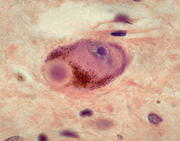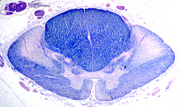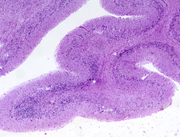M2 NEUROPATHOLOGY LAB
QUIZ 15
Case A
Case B
Case C
Case D
Case E
Match the case histories with Images 71-75.
71 72
72
73
 74
74  75
75 
#74 is a myelin stain.
Case A
A 56-year-old woman developed paranoid ideas and difficulty
naming objects. She lost vocabulary, and her speech
became repetitive and stereotyped. She appeared anxious.
Memory failure developed (though she could remember
songs), and dementia set in. She became confused
and withdrawn and began to perform ritualistic tasks.
She had no seizures or motor deficits. Dementia progressed,
and she died in a nursing home 7 years after the
onset of her disease.
Case B
A 62-year-old man had tremor of the hands and head
and rhythmic tongue protrusion. He became stiff and
walked with small steps in a stooped posture. He
was treated with L-dopa and other medications without
significant improvement. Four years after the onset
of these symptoms, intellectual deterioration and
memory loss developed. He died in a nursing home
at age 69.
Case C
A 58-year-old woman had a gradual onset of difficulty
walking characterized by staggering, especially when
walking in the dark. She had no history of alcoholism
and was well nourished. Neurological exam revealed
a wide-based gait and abnormal cerebellar testing.
While gait difficulty progressed, tremor of the hands
and difficulty writing appeared. She had a mask-like
face. Treatment with sinemet was without effect.
Then, she developed orthostatic hypotension and bladder
incontinence. Mental status remained normal. She
died 14 years after the onset of her illness.
Case D
A 70-year-old man developed progressive confusion,
difficulty sleeping, and jerks of all limbs. The
symptoms worsened and he lost fine motor control
of both hands and became ataxic. He became confused
and demented. Speech was an incomprehensible jargon.
CSF was normal. MRI revealed mild cortical atrophy.
EEG was abnormal. He died four months after the onset
of his illness.
Case E
A 63-year-old man developed weakness of the left leg
and then of the right leg and both hands. His grip
became weak and he began dropping things. Weakness
progressed, resulting in frequent falls. His voice
changed and he began to drool and had difficulty
swallowing. He became bedridden. There were fasciculations
of his tongue. Deep tendon reflexes were hyperactive,
and plantar responses were extensor. Intelligence
and sensation were not affected. He had difficulty
breathing and died three years after the onset of
his illness.
ALL LECTURE PODCASTS ARE EMBEDDED IN THEIR RESPECTIVE
NEUROPATHOLOGY PAGES AND CAN ALSO BE FOUND ON THE
VIMEO CHANNEL "DIMITRI
AGAMANOLIS NEUROPATHOLOGY"